Showing Spotlights 25 - 32 of 80 in category All (newest first):
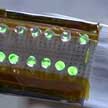 Notwithstanding the progress in extracting renewable energy from many natural resources through nanotechnologies, some 60 research groups worldwide have now begun to develop triboelectric nanogenerators (TENGs) for harvesting energy from 'good (mechanical) vibrations' including human walking and ocean waves, which are otherwise wasted. Nanostructuring the materials in a TENG device amplifies the produced energy by increasing the contact area of the surfaces. Researchers have found a new way to scalably manufacture large area TENGs with a very high-throughput using off-the-shelf materials.
Notwithstanding the progress in extracting renewable energy from many natural resources through nanotechnologies, some 60 research groups worldwide have now begun to develop triboelectric nanogenerators (TENGs) for harvesting energy from 'good (mechanical) vibrations' including human walking and ocean waves, which are otherwise wasted. Nanostructuring the materials in a TENG device amplifies the produced energy by increasing the contact area of the surfaces. Researchers have found a new way to scalably manufacture large area TENGs with a very high-throughput using off-the-shelf materials.
Apr 12th, 2017
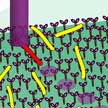 One way to construct useful molecular machines is to combine natural molecules - such as proteins or DNAs in our body - with synthetic molecules in order to control the functions of the natural molecules. Building on previous work that allowed to achieve complete control over on/off switching of the movement of a nanomachine, researchers in Japan have, for the first time, developed a molecular system which allows free control of the motion of single microtubules. The microtubules, tube-like structure with measuring 25 nm in diameter, could potentially serve as carriers of various molecular cargoes in future nano-transportation systems.
One way to construct useful molecular machines is to combine natural molecules - such as proteins or DNAs in our body - with synthetic molecules in order to control the functions of the natural molecules. Building on previous work that allowed to achieve complete control over on/off switching of the movement of a nanomachine, researchers in Japan have, for the first time, developed a molecular system which allows free control of the motion of single microtubules. The microtubules, tube-like structure with measuring 25 nm in diameter, could potentially serve as carriers of various molecular cargoes in future nano-transportation systems.
Nov 8th, 2016
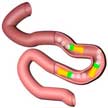 Researchers have developed an enteric micromotor consisting of a magnesium-based motor body with an enteric polymer coating. These motors, aimed controlling and enhancing site-specific delivery in the gastrointestinal tract, consist of water-powered magnesium-based tubular micromotors coated with an enteric polymer layer. The microscale robot can deliver payload to particular location via dissolution of their enteric polymeric coating to activate their propulsion at the target site towards localized tissue penetration and retention.
Researchers have developed an enteric micromotor consisting of a magnesium-based motor body with an enteric polymer coating. These motors, aimed controlling and enhancing site-specific delivery in the gastrointestinal tract, consist of water-powered magnesium-based tubular micromotors coated with an enteric polymer layer. The microscale robot can deliver payload to particular location via dissolution of their enteric polymeric coating to activate their propulsion at the target site towards localized tissue penetration and retention.
Sep 27th, 2016
 Quantum computation using artificial-atoms can be sensitively controlled by external electromagnetic fields. These fields and the self-fields attributable to the coupled artificial-atoms influence the amount of quantum correlation in the system. However, control elements that can operate without complete destruction of the entanglement of the quantum-bits are difficult to engineer. In new work, scientists have investigate the possibility of using closely spaced-linear arrays of metallic-elliptical discs as whispering gallery waveguides to control artificial atoms.
Quantum computation using artificial-atoms can be sensitively controlled by external electromagnetic fields. These fields and the self-fields attributable to the coupled artificial-atoms influence the amount of quantum correlation in the system. However, control elements that can operate without complete destruction of the entanglement of the quantum-bits are difficult to engineer. In new work, scientists have investigate the possibility of using closely spaced-linear arrays of metallic-elliptical discs as whispering gallery waveguides to control artificial atoms.
May 10th, 2016
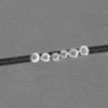 Researchers engineered synthetic nanomotors that self-propel and autonomously detect surface cracks in electronic devices and rapidly restore the conductive pathway. These nanomotors were inspired by the chemotaxis of neutrophils toward inflammation sites and the aggregation of platelets at the collagen fibers of a wound to stop bleeding. The catalytic nanomotors are composed of conductive gold/platinum spherical Janus particles that self-propel efficiently in the presence of hydrogen peroxide fuel.
Researchers engineered synthetic nanomotors that self-propel and autonomously detect surface cracks in electronic devices and rapidly restore the conductive pathway. These nanomotors were inspired by the chemotaxis of neutrophils toward inflammation sites and the aggregation of platelets at the collagen fibers of a wound to stop bleeding. The catalytic nanomotors are composed of conductive gold/platinum spherical Janus particles that self-propel efficiently in the presence of hydrogen peroxide fuel.
Sep 22nd, 2015
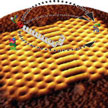 In new work, researchers have utilized diffusion as an effective transport mechanism for DNA nanotechnology. These findings contribute a new aspect to be considered for the design of future DNA motors, molecular machines, and nanorobots as they provide a simple way to transport molecules over distances of potentially several 100 nm; which is much faster than when using conventional DNA walkers or motors, which make many small and slow steps.
In new work, researchers have utilized diffusion as an effective transport mechanism for DNA nanotechnology. These findings contribute a new aspect to be considered for the design of future DNA motors, molecular machines, and nanorobots as they provide a simple way to transport molecules over distances of potentially several 100 nm; which is much faster than when using conventional DNA walkers or motors, which make many small and slow steps.
Mar 19th, 2015
 New findings address the challenges of operating synthetic motors in living organisms through the use of biocompatible motors that are powered by body fluid (acidic stomach environment). As the zinc body of the motor is dissolved by the acid fuel, the motors are self-destroyed, leaving no harmful chemicals behind. The study reports on the distribution, retention, cargo delivery and toxicity profile of zinc/polymer-based microrockets in a mouse stomach.
New findings address the challenges of operating synthetic motors in living organisms through the use of biocompatible motors that are powered by body fluid (acidic stomach environment). As the zinc body of the motor is dissolved by the acid fuel, the motors are self-destroyed, leaving no harmful chemicals behind. The study reports on the distribution, retention, cargo delivery and toxicity profile of zinc/polymer-based microrockets in a mouse stomach.
Jan 15th, 2015
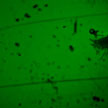 Researchers have demonstrated an active glucose-responsive self-powered fluidic pump based on transesterification reaction of acyclic diol boronate with glucose. The scientific principle of the project is to use well-known glucose/boronate chemistry to design a self-powered micropump device. Instead of synthesizing some new molecules with glucose/boronate reaction, a miniature pump utilizes the energy of this chemical reaction and pumps drugs when glucose levels are high.
Researchers have demonstrated an active glucose-responsive self-powered fluidic pump based on transesterification reaction of acyclic diol boronate with glucose. The scientific principle of the project is to use well-known glucose/boronate chemistry to design a self-powered micropump device. Instead of synthesizing some new molecules with glucose/boronate reaction, a miniature pump utilizes the energy of this chemical reaction and pumps drugs when glucose levels are high.
Aug 19th, 2014
 Notwithstanding the progress in extracting renewable energy from many natural resources through nanotechnologies, some 60 research groups worldwide have now begun to develop triboelectric nanogenerators (TENGs) for harvesting energy from 'good (mechanical) vibrations' including human walking and ocean waves, which are otherwise wasted. Nanostructuring the materials in a TENG device amplifies the produced energy by increasing the contact area of the surfaces. Researchers have found a new way to scalably manufacture large area TENGs with a very high-throughput using off-the-shelf materials.
Notwithstanding the progress in extracting renewable energy from many natural resources through nanotechnologies, some 60 research groups worldwide have now begun to develop triboelectric nanogenerators (TENGs) for harvesting energy from 'good (mechanical) vibrations' including human walking and ocean waves, which are otherwise wasted. Nanostructuring the materials in a TENG device amplifies the produced energy by increasing the contact area of the surfaces. Researchers have found a new way to scalably manufacture large area TENGs with a very high-throughput using off-the-shelf materials.
 Subscribe to our Nanotechnology Spotlight feed
Subscribe to our Nanotechnology Spotlight feed





